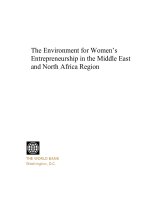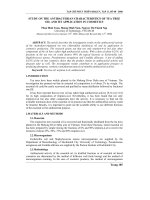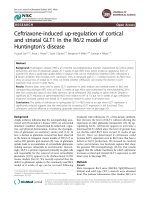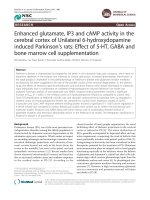OFFSHORE OIL AND GAS SAFETY AND S ECURITY IN THE ASIA PACIFIC THE NEED FOR REGIONAL APPRO ACHES TO MANAGING RISKS
Bạn đang xem bản rút gọn của tài liệu. Xem và tải ngay bản đầy đủ của tài liệu tại đây (1.02 MB, 104 trang )
Offshore Oil and Gas
Safety and Security
in the Asia Pacific
The Need for Regional Approaches
to Managing Risks
RSIS Monograph No. 26
Lee Cordner
ix
x
RSIS MONOGRAPH NO. 26
Offshore Oil and Gas
Safety and Security
in the Asia Pacific
The Need for Regional
Approaches to Managing Risks
Lee Cordner
S. Rajaratnam School of International Studies
Note
The opinions expressed herein are those of
the author and do not necessarily reflect
those of the Editors or of RSIS.
Copyright © 2013 Lee Cordner
Published by
S. Rajaratnam School of International Studies
Nanyang Technological University
South Spine, S4, Level B4, Nanyang Avenue
Singapore 639798
Telephone: 6790 6982 Fax: 6793 2991
E-mail:
Website: www.rsis.edu.sg
First published in 2013
All rights reserved. No part of this publication may be reproduced, stored in
a retrieval system, or transmitted in any form or by any means, electronic,
mechanical, photocopying, recording or otherwise, without the prior written
permission of the S. Rajaratnam School of International Studies.
Produced by BOOKSMITH
()
ISBN 978-981-07-5770-0
TABLE OF CONTENTS
Map of the Region vi
About the Author viii
Executive Summary 1
Chapter 1 Offshore Oil and Gas Exploration 5
Chapter 2
Chapter 3 and Exploitation in the Asia Pacific
Chapter 4
Chapter 5 International Offshore Oil and Gas Safety 13
Chapter 6 and Security Incidents
International Risk Management Approaches 31
Asia Pacific 49
Regional Safety and Security Challenges
Policy Response Practices and Options 62
Regional Risk Realities 86
Is a Disaster Inevitable?
The RSIS/IDSS Monograph Series
Monograph No. Title
1Neither Friend Nor Foe
Myanmar’s Relations with Thailand since 1988
2China’s Strategic Engagement with the New ASEAN
3 Beyond Vulnerability?
Water in Singapore-Malaysia Relations
4A New Agenda for the ASEAN Regional Forum
5The South China Sea Dispute in Philippine Foreign
Policy
Problems, Challenges and Prospects
6The OSCE and Co-operative Security in Europe
Lessons for Asia
7 Betwixt and Between
Southeast Asian Strategic Relations with the U.S. and
China
8Fading Away?
The Political Role of the Army in Indonesian
Transition to Democracy, 1998–2001
9 The Post-Tsunami Reconstruction of Aceh and the
Implementation of the Peace Agreement
10 Post-Suharto Civil-Military Relations in Indonesia
11 People’s ASEAN and Governments’ ASEAN
12Forgetting Osama Bin Munqidh, Remembering Osama
bin Laden
The Crusades in Modern Muslim Memory
The RSIS/IDSS Monograph Series
Monograph No. Title
13Do Institutions Matter?
Regional Institutions and Regionalism in East Asia
14 Population Movements and the Threat of HIV/AIDS
Virus at the Bangladesh-India Border
15Collaboration under Anarchy
Functional Regionalism and the Security of East Asia
16 Pandemic Preparedness in Asia
17The 2008 Mumbai Terrorist Attacks
Strategic Fallout
18Islamic Education in Malaysia
19 Practising Strategic Foresight in Government
The Cases of Finland, Singapore and the European
Union
20A Decade of Combating Radical Ideology
Learning from the Singapore Experience (2001–2011)
21From ‘Boots’ to ‘Brogues’
The Rise of Defence Diplomacy in Southeast Asia
22ASEAN-China Free Trade Area
Challenges, Opportunities and the Road Ahead
23India-Japan Relations
Drivers, Trends and Prospects
24Climate Change, Migration and Human Security in
Southeast Asia
25Demilitarising the State
The South and Southeast Asian Experience
Map of the Region
PAKISTAN NEPAL BHUTAN CHINA
INDIA
BANGLADESH
MYANMAR VIETNAM
LAOS
Arabian Bay of Bengal ANDAMAN THAILAND
Sea ISLANDS
CAMBODIA
Andaman Gulf
Sea
of
SRI LANKA Thailand
NICOBAR
ISLANDS MALAYSIA
SINGAPORE
MALDIVES
SUMATRA
JAVA
Indian Ocean
vi
HONG TAIPEI
KONG
South Philippine Sea
China PHILIPPINES
Sea
Pacific Ocean
BRUNEI Celebes
Sea
BORNEO Banda IRIAN
INDONESIA Sea JAYA PAPUA
EAST TIMOR NEW
GUINEA
AUSTRALIA
vii
About the Author
Lee Cordner is a strategic analyst who has worked as a policy
adviser, consultant, practitioner, researcher and educator on
maritime security and international security issues for many years.
His interests include maritime security and strategy, international
relations, high level policy analysis and development, enterprise
risk management, strategic planning and organisational behav-
iour. Current projects include Indian Ocean maritime security
governance and offshore oil and gas safety and security. Lee was
co-chair of the Council for Security Cooperation in the Asia-Pacific
(CSCAP) Study Group on offshore oil and gas safety and security
in the Asia Pacific.
Lee is currently at the Indo-Pacific Governance Research
Centre, University of Adelaide, Australia. He was a Principal
Research Fellow at the Australian National Centre for Ocean
Resources and Security, University of Wollongong, Australia;
and formerly CEO of Future Directions International Pty Ltd, an
independent strategic think-tank based in Perth, Australia. He
served in the Royal Australian Navy for 33 years and commanded
several warships; his last Navy position was Director-General Navy
Strategic Policy and Futures in the rank of Commodore.
Email: or
Mobile (Cell): +61 (0) 427 333 034.
viii
Executive summary
This report explores the safety and security risks associated with
the massive expansion of offshore oil and gas exploration and
exploitation activity in the Asia Pacific region. The pursuit of
national and commercial objectives is generating the convergence of
wider interests and uncertainties, and therefore significant and often
shared risks. Risk mitigating options for action are presented that need
to be urgently and collaboratively considered by multiple actors: states,
regional cooperative entities, and industry.
Many major offshore oil and gas safety incidents around the world
have been attributed to man-induced hazards resulting from human
error, technology or equipment failures, regulatory failures, or a combi-
nation of these. Further, the Asia Pacific region has the highest incidence
of natural hazards in the world from extreme weather events and seismic
activity, with the former projected to increase due to climate change.
The possibility of armed conflict at sea, law and order issues, increasing
maritime user intensity, decommissioned installations, and jurisdictional
uncertainty, where the geographical limits of national responsibilities
and obligations for safety and security may be unclear, add to security
and safety concerns in economically and strategically important, envi-
ronmentally sensitive areas.
In the Asia Pacific, measures to deal with large-scale offshore oil
and gas safety and security incidents are often not well developed. As
evident elsewhere in the world, responses to catastrophic accidents with
significant environmental and human security consequences are unlikely
to be adequate. Vulnerabilities arise from the lack of capacity and the
lack of coordination regimes to prevent, respond to and recover from
incidents; and the lack of cooperative arrangements for maritime safety
and security.
1
RSIS Monograph No. 26
Key messages from the West Atlas (Australia, 2009) Commissioner’s
Report and the Deepwater Horizon (United States, 2010) Commission of
Inquiry that should resonate across the Asia Pacific include: lax regula-
tion and industrial complacency, combined with driving political and
commercial expediency, work together to build cumulative risks that
ultimately create circumstances where systemic, organisationally induced
accidents are certain to occur; and effective risk management requires
partnerships between regulators and those being regulated, between
governments and industry, where each partner performs its role dili-
gently and with integrity. Governance arrangements and relationships
are critical.
There is little evidence so far that all regional governments and
industry are paying attention to the rising, cumulative risks to safety and
security that increased offshore oil and gas activity is generating. Regional
states appear to be consumed by the rush to claim and exploit as much
of the valuable resources as possible. Collaboration between states and
other actors, particularly regional cooperative entities and industry, is
necessary, presents mutually beneficial opportunities, and is therefore
logical. The strategic, economic and environmental interests of regional
states and other actors will be enhanced by pursuing cooperative activity
at sea; they will remain diminished until this occurs.
Given the extent of the safety and security uncertainties and the
lack of cooperative arrangements an uncomfortable conclusion must be
drawn: offshore oil and gas disasters in the Asia Pacific are inevitable.
The only questions that remain to be answered are where, when and
what the scale of the disasters will be, and how effective response and
recovery arrangements will prove to be.
The onus lies with regional governments, cooperative entities and
industry, supported by extra-regional governments and entities with
interests at stake, to ensure that the risks are fully understood and that
appropriate mitigation arrangements are put in place. Cooperative
mechanisms, arrangements, protocols, policies, equipments and training
need to be prepared and tested before major incidents occur.
Asia Pacific regional cooperative bodies and individual states, in con-
cert with industry partners, are urged to consider the following actions:
1. Offshore oil and gas safety and security should feature as a major
2
Executive Summary
and discrete agenda item with regional safety, security, economic,
environmental and disaster response cooperative bodies. Enti-
ties like ARF, EAS, APEC, ASEAN and SAARC, and relevant
subordinate agencies, should commission independent expert
working groups directed to review and report recommendations
and options to develop regional measures.
2. A significant and essential initial activity of such working groups
should be to commission strategic, all-factors offshore oil and
gas benchmark risk assessments to establish objective bases for
individual and cooperative risk management initiatives.
3. UNCLOS Articles 122 and 123 provide an international legisla-
tive foundation for targeted regional cooperative and national
initiatives that should be acted upon in the South China Sea,
noting the majority of Asia Pacific states covered by this review
have ratified UNCLOS (see Chapter 5) and the South China Sea
is generally recognised by littoral states as a semi-enclosed sea
(see Chapter 3).
4. States should, as a matter of priority, accede to relevant mari-
time and marine safety, security and environmental protection
conventions and protocols. Establishing associated national
legislation, regulations and capabilities, and regional cooperative
arrangements, would follow. Specifically, regional states should
establish and where they already exist, enhance regional coopera-
tive regimes to deal with:
a. maritime search and rescue;
b. marine environmental protection including pollution, dump-
ing and decommissioning of offshore installations;
c. maritime safety and security arrangements to include inci-
dents at sea protocols;
d. establishing common, best practice approaches to offshore
oil and gas safety and security regulation, to include industry
engagement, this may include establishing regional govern-
ment-industry cooperative agencies to provide advice and
coordination;
e. develop individual state and collective offshore arrangements
and capabilities for disaster management to include preven-
3
RSIS Monograph No. 26
tion of, recovery from and response to offshore oil and gas
incidents; and
f. enhancing and sharing scientific information that include
marine science, oceanographic, hydrographic, seismic, and
meteorology data in order to better understand and therefore
prevent and prepare responses and recovery arrangements to
deal with the environmental impacts of incidents.
5. Encourage regional states to resolve or agree to set aside mari-
time boundary delimitation disputes in the interests of mutually
beneficial economic, security, safety and environmental out-
comes.
6. Encourage all parties involved in offshore oil and gas safety and
security, including states and industry, to adopt internation-
ally recognised and proven, best practice risk management
approaches. Effective risk management requires partnerships
between the regulator and those being regulated, between
government and industry, where each partner performs its role
diligently and with integrity.
4
Chapter 1
OFFSHORE OIL AND GAS
EXPLORATION AND EXPLOITATION
IN THE ASIA PACIFIC
Massive increases in offshore oil and gas exploration and exploi-
tation activity and investment in the Asia Pacific region are
driven by economic growth and the associated rising demand
for energy in Asia. Economic growth in China and India is predicted to
continue at an average of greater than five per cent per annum through
to 2035.1 While coal and nuclear power will meet much of the energy
increase the demand for oil will also rise. The largest increase in demand
will be for natural gas with non-OECD Asia,2 led by China and India,
likely to increase its share of world natural gas consumption from 10 per
cent in 2008 to 19 per cent in 2035; gas consumption volume is forecast
to increase by an average of 3.9 per cent annually.3
This review explores the safety and security risks associated with the
expansion of offshore oil and gas exploration and exploitation activity.
The focus is on Asia Pacific maritime domains, also referred to as the
Indo-Pacific region in recognition of the vast and strategically impor-
tant geographic construct whose central feature is the confluence of the
world’s two great oceans.4 The geographical coverage of the Asia Pacific
1 U.S. Energy Information Administration (EIA), International Energy Outlook
2011 (IEO2011), viewed 9 August 2012, < /> pdf/0484(2011).pdf>, p. 19.
2 The only Asian OECD member nations are Japan and the Republic of Korea.
3 EIA, op. cit., p. 48–49.
4 Dennis Rumley, Timothy Doyle and Sanjay Chaturvedi, “‘Securing’ the Indian
Ocean? Competing regional security constructions”, Journal of the Indian Ocean
Region, Vol. 8, No. 1, June 2012, pp. 1–20. The authors identify three “competing”
regional security constructs: an “all-embracing concept of an Indian Ocean
region; a more limited “East Indian Ocean”; and an “Indo-Pacific concept that
emphasises the pre-eminence of regional naval power” where India is a dominant
player and extra-regional powers like the United States and China play important
roles (pp. 2–3).
5
RSIS Monograph No. 26
Offshore Oil and Gas Safety and Security in the Asia Pacific: The Need for Regional
Approaches to Managing Risks
region addressed here extends from Russia’s Pacific coast south through
the western Pacific Ocean to the northeast Indian Ocean including
waters to the northwest of Australia, the Andaman Sea, Bay of Bengal
and India. A primary area of interest is the South China Sea and, to a
lesser extent the East China Sea, due to the proliferation of offshore oil
and gas activity in waters claimed by numerous littoral states in crowded,
environmentally sensitive and strategically important waters.
The analysis is conducted from regional, national and industry gov-
ernance and risk management perspectives. The aim is to identify the
major risks, assess the likelihood and consequences of the risks arising,
explore policy and cooperative governance options for mitigating risks
and consider the strategic implications for regional safety and security.
The analysis draws upon experience with offshore oil and gas safety and
security risk management and governance in other parts of the world.
This includes reviewing selected major incident lessons and regional
policy responses and arrangements.
Some may question the appropriateness of adopting a risk manage-
ment driven approach to offshore oil and gas safety and security govern-
ance rather than more traditional approaches. The following quote from
the Deepwater Horizon Report to the President of the United States,5
when referring to the largest offshore oil and gas generated environmen-
tal disaster in United States history, points to the answer:
Government agencies that regulate offshore activity should reorient
their regulatory approaches to integrate more sophisticated risk assess-
ment and risk management practices into their oversight of energy
developers operating offshore.6
Global Energy Forecasts
Global pressures to find and exploit new energy sources will continue
to mount into the foreseeable future due to vast increases in the
5 National Commission on the BP Deepwater Horizon Oil Spill and Offshore
Drilling, Report to the President, Deep Water The Gulf Oil Disaster and the Future
of Offshore Drilling, January 2011.
6 Ibid., p. 251.
6
Chapter 1
Offshore Oil and Gas Exploration and Exploitation in the Asia Pacific
demand for energy, primarily from developing countries. According
to the International Energy Agency (IEA) conservative New Policies
Scenario, with projections that include the likely impact of policies
intended to mitigate climate change, world energy demand is fore-
cast to increase by one-third between 2010 and 2035.7 Similarly, the
U.S. Energy Information Administration (EIA), International Energy
Outlook 2011 Reference case, which does not incorporate prospective
legislation or policies that might affect energy markets, projects that
world marketed energy consumption will grow by 53 per cent from
2008 to 2035.8 While both IEA and EIA analyses recognise there are
uncertainties in their projections, due to global economic growth
variations and possible environmental policy changes, the deviations
are unlikely to be significant.
Notably, 90 per cent of the projected growth in global energy demand
will come from outside OECD countries9 with China accounting for
more than 30 per cent. China will be the world’s largest energy consumer,
increasing to more than 70 per cent higher than the United States, by
2035. Energy consumption rates in developing Asia Pacific economies,
including India and Indonesia, are forecast to grow even faster than
China. Fossil fuels (coal, oil and gas) will continue to meet more than 75
per cent of global demand.10
According to the IEA, global natural gas demand is forecast to grow
at 1.7 per cent per annum, almost twice the rate of oil and coal, with the
major demand coming from China and other non-OECD countries.11 The
EIA assesses that world natural gas consumption would likely increase by
52 per cent between 2008 and 2035 and notes that natural gas continues
to be the fuel of choice in many regions because its relatively low carbon
intensity makes it an attractive option for nations interested in reducing
7 International Energy Agency (IEA), World Energy Outlook 2011 Factsheet,
viewed 9 August 2012, < /> factsheets/factsheets.pdf>.
8 EIA, op. cit., p. 19.
9 There are 34 OECD member countries from North and South America to Europe
and the Asia-Pacific region see OECD Members and Partners, viewed 9 August
2012, < .
10 IEA, loc. cit.
11 Ibid.
7
RSIS Monograph No. 26
Offshore Oil and Gas Safety and Security in the Asia Pacific: The Need for Regional
Approaches to Managing Risks
greenhouse gas emissions, it has relatively low capital costs and is fuel
efficient.12
The EIA predicts that increased natural gas usage in non-OECD Asia
will be led by India and China. China’s central government promotes
natural gas as a preferred energy source. Natural gas usage in India is
forecast to grow by 4.6 per cent per annum, with supply constraints
continuing to hold down consumption.13 The largest increases in import
demand are projected for China and India, which together will require
imports of 6.0 trillion cubic feet per annum in 2035. By 2035, China will
import 40 per cent of its natural gas consumption and India 28 per cent.
China is actively pursuing multiple potential sources for natural gas
imports. At the end of 2010, China had four liquid natural gas (LNG)
import terminals in operation, four under construction, and several more
proposed or in various stages of development.14
On the supply side, natural gas production in Australia is predicted
to grow at an average of 4.5 per cent per annum, the strongest growth
among OECD countries.15 While emerging economies will increasingly
dictate energy demand they are also projected to dominate the expan-
sion of natural gas supply with non-OECD countries accounting for 70
per cent of gas production by 2035. Concomitantly, the world will rely
increasingly on OPEC16 oil production that will reach more than half the
world total by 2035.17
The projected growth in future energy requirements will demand
12 EIA, op. cit., p. 2.
13 EIA, op. cit., pp. 48–49.
14 EIA, op. cit., p. 62. China is importing natural gas under long-term contracts
from four countries, with no single country to provide more than 37 percent of
the total contracted volume. Chinese companies have signed contracts to increase
imports from Australia, Qatar and Malaysia.
15 EIA, op. cit., p. 52.
16 There are 12 Organization of the Petroleum Exporting Countries (OPEC)
member countries: Iran, Iraq, Kuwait, Saudi Arabia, Venezuela, Qatar, Indonesia,
Libya, the United Arab Emirates, Algeria, Nigeria and Angola. See OPEC Member
Countries, viewed 9 August 2012, < /> us/25.htm>.
17 IEA, loc. cit.
8
Chapter 1
Offshore Oil and Gas Exploration and Exploitation in the Asia Pacific
massive investments in energy-supply infrastructure, estimated at US$38
trillion from 2011 to 2035, with almost US$20 trillion required for oil and
gas.18 An important point to note is that climate change policies are not
predicted to have a significant impact on the demand for and investment
in global energy because so much is predicated upon the needs of rapidly
expanding, developing economies. Investment in Asia Pacific offshore
oil and gas activity will demand a relatively small proportion of the total
investment in energy compared with offshore Brazil or West Africa and
onshore investment elsewhere in the World. However, the scale of invest-
ment in Asia Pacific offshore oil and gas exploration and exploitation is
significant, expanding and will present major and increasing strategic,
economic and environmental challenges.
Implications for Asia Pacific Offshore Oil and Gas
The search for offshore oil and gas in the Asia Pacific region is rapidly
expanding and intensifying commensurate with the increasing global
and regional demand for energy and as production from mature fields’
declines.19 According to Infield Systems Ltd,20 total capital expenditure
commitments on offshore oil and gas development in the region are
expected to exceed US$90 billion during 2011–2015, a 55 per cent
increase from the previous five-year period.21 Projected offshore field
developments for the period 2012–2015, which are based upon industry-
sourced contracted commitments, indicate the vast scale of this activity.
18 IEA, loc. cit.
19 International Energy Agency, World Energy Outlook 2008, 39, viewed 15 January
2011, <> , pp. 42–43.
20 Infield Systems Ltd. Infield “is an independent energy research and analysis
firm that is dedicated to the provision of accurate and up-to-date information,
databases, research, market forecasts, mapping, commercial market due-
diligence, transaction support, business strategy, analysis and intelligence to the
global offshore oil, gas, renewable energy and associated marine industries.” A
wealth of detailed energy industry data and analyses are available, mostly for
significant fees. See < />21 Gene Kliewer, “Asia/Pacific economic growth drives exploration/production
offshore”, Offshore, Volume 72, Issue 5, 5 February 2012, viewed 8 August 2012,
< />
9
RSIS Monograph No. 26
Offshore Oil and Gas Safety and Security in the Asia Pacific: The Need for Regional
Approaches to Managing Risks
In South Asia, Southeast Asia, East Asia and Australasia there are 441
projected shallow (less than 300 metres) and deep water (greater than
300 metres) oil and gas fields22 involving thousands of exploratory drill-
ings. 387 new sub-sea wells are contracted with a combined total of 70
floating production, storage and offloading vessels (FPSOs), floating
production systems (FSPs) and floating storage and offloading units
(FSOs)23 plus over 14,000 kilometres of rigid and flexible flow lines.24 By
far the greater proportion of the activity, 237 fields,25 is occurring in the
South China Sea.
Major Offshore Oil and Gas Fields
Major areas of offshore oil and gas exploration and exploitation
covered by this analysis include several new areas offering potential
oil and gas production. They range from the Mumbai High Basin off
India’s west coast, and the Bay of Bengal;26 the northwest shelf and
Timor Basin areas off north-western Australia; the South China Sea
where variously Malaysia, Brunei, China, Taiwan, Vietnam and the
Philippines are active in the Spratly and Paracel Island areas; Indo-
nesian offshore developments that are progressing in the Makassar
22 Ibid. Based upon Infield data, the 441 break down is: 397 shallow fields and 44
deep water fields; 75/10 Australasia, 68/6 East Asia, 34/11 South Asia and 220/17
South East Asia.
23 Ibid. The breakdown of the 70 floating facilities is: 31 FPSO, 18 FPS and 21 FSO;
with the majority (49) in the South East Asia area.
24 Ibid.
25 Ibid.
26 MBendi Information Services, Oil and Gas in India – Overview, viewed 3
September 2012 < The
bulk of India’s natural gas production comes from the western offshore regions,
especially the Mumbai High field. There have been several large natural gas finds
in India over the last five years, predominantly offshore in the Bay of Bengal.
10









